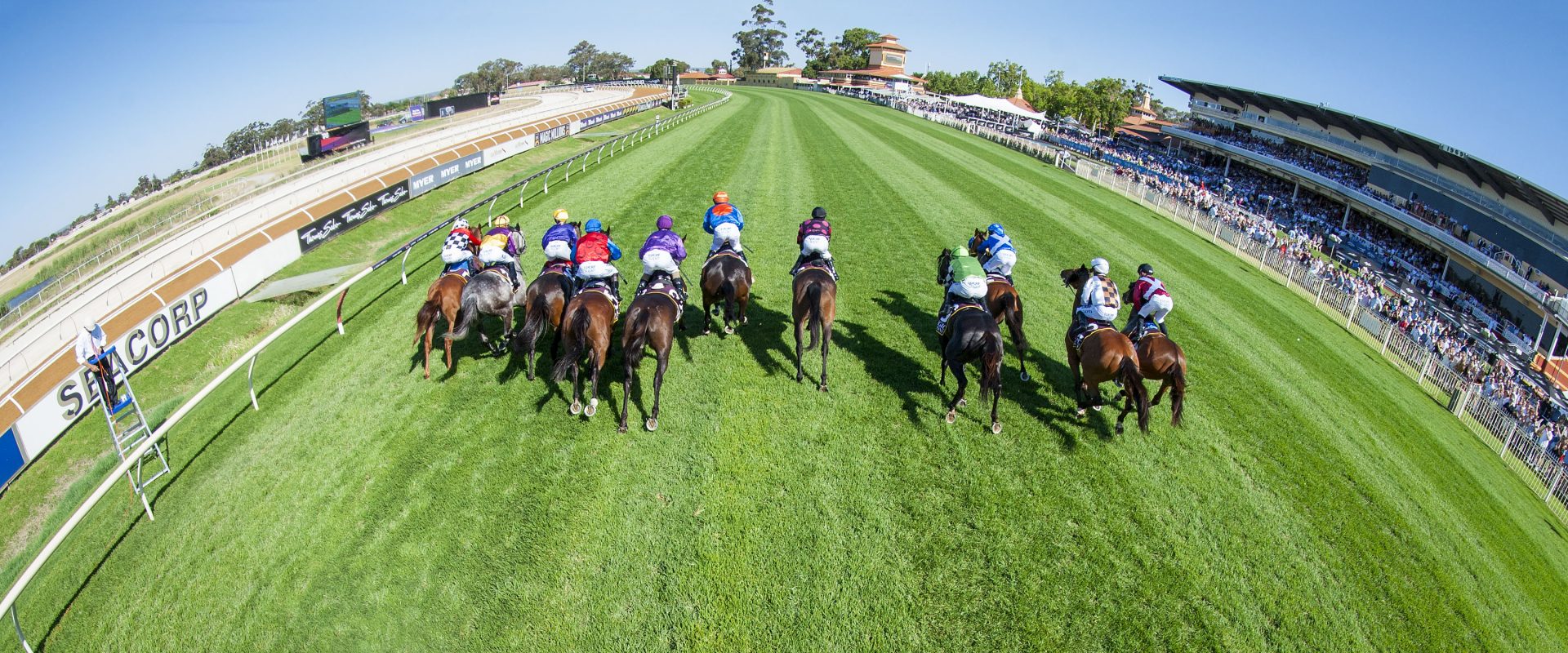
21 Jan Off The Track Nutrition
While horses are racing, their diet is carefully calculated and formulated to support the requirements of high intensity performance. When they retire, these requirements change dramatically. With a change in diet, their digestive systems also undergo changes, and understanding these can help you build the right plan for your horse.
Before you start...
Before you start adjusting your horses diet, here are some important checks you should carry out. You could save yourself time and money in the long run!
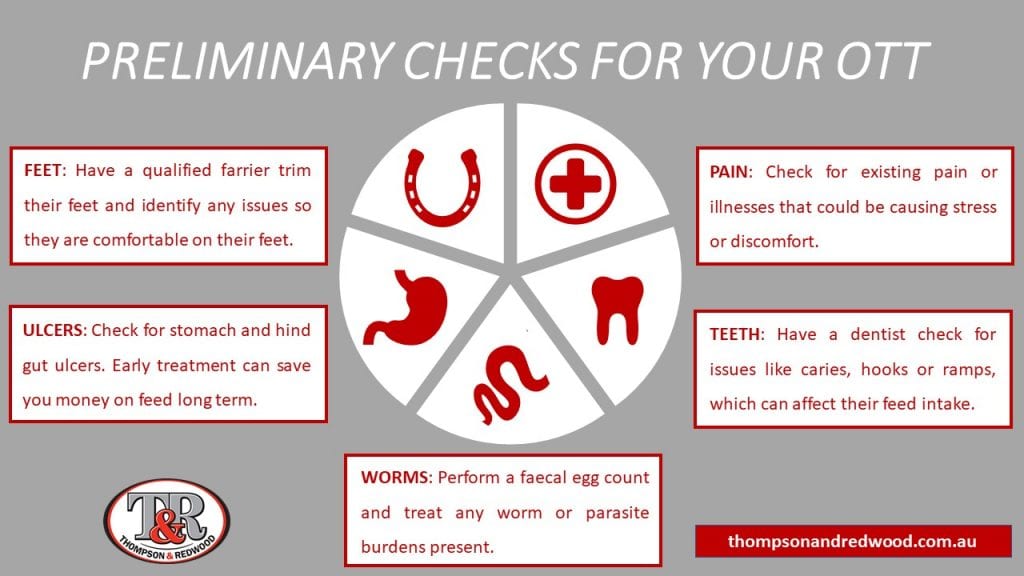
Ulcers: checking for both stomach and hind gut ulcers early can save you time and money! It can be cheaper to treat ulcers than add expensive supplements long term. A vet can help you with this.
Teeth: it’s a good idea to get their teeth checked for any issues like caries, hooks or ramps, which could affect their feed intake, but also their happiness with a bit in their mouth.
Worming: a faecal egg count shows you the worm burden your horse carries, and what you will need for treatment. Getting rid of any worm burdens allows your horse to digest efficiently without any parasites interfering.
Feet: get their hooves trimmed by a qualified farrier who can identify any issues, and make sure your horse is comfortable on their feet.
Pain: check for illness, injuries or tightness that might cause your OTT pain or stress. Something like back pain or tightness can stop them from grazing comfortably.
If you can talk to your horse’s trainer or previous owner, ask them about the horses’s history and any previous issues they might have had. ‘Knowledge is Power’, and the more you know about your horse, the more power you’ll have to help them!
THE GUT - THE KEY TO YOUR OTT HORSE'S HEALTH
Gut bacteria are vital in the digestion process. This is because they take food sources like grain or hay, and break them down into a form that is easily digestible by the horse. They are highly specialised.
For example: starch-loving bacteria, can only turn starch into digestible energy.
Like any group of living organisms, their population size is restricted by their available food source. Therefore a diet high in starch, means a high population of starch-loving bacteria.
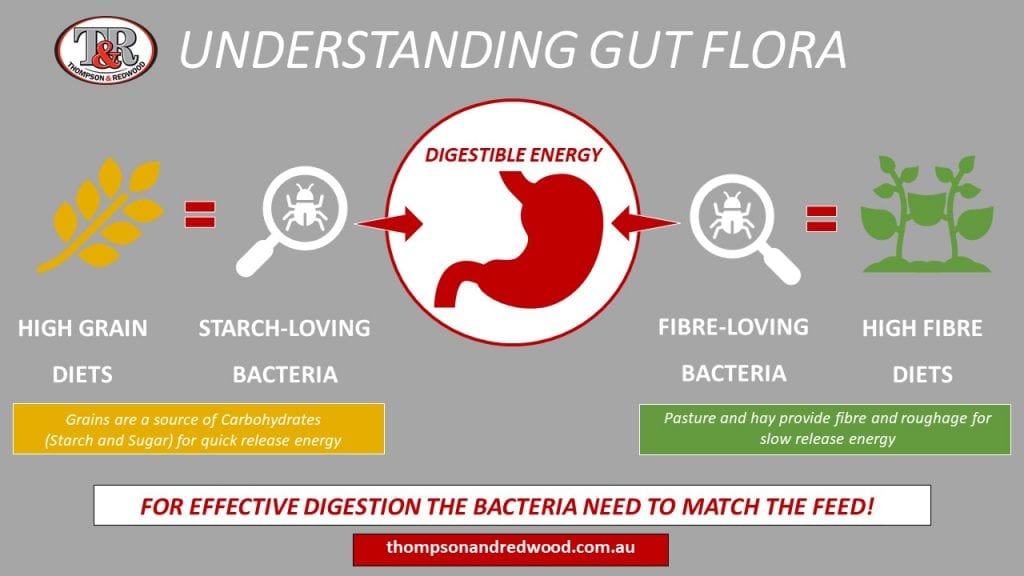
Most racehorses are fed a high-grain diet, which provides carbohydrates in the form of starch and sugar for quick release energy. A high amount of starch promotes a high population of starch-loving bacteria. This means the horse’s gut will not be efficient at digesting fibre.
Off the Track horses need more slow release energy, so are generally fed a diet higher in fibre. Good hind gut health for an OTT horse means they need a high population of fibre-loving bacteria.
To do this, we need to convert the bacteria in their guts over time, by growing the population of fibre-loving bacteria. This transition is part of “Letting Down”.
During the Letting Down period, your horse should still keep, if not improve in condition. For this to happen, they still need to be getting good digestible energy from their feed source.
- DON’T: switch your horse straight onto a low-energy, high fibre diet, i.e. 100% pasture or hay.
- DON’T: make any sudden changes, introduce any changes slowly.
- DO: Decrease the grain content, and introduce an intermediate feed.
- DO: make small alterations over time as their condition changes, and workload increases.
The building blocks FOR an OTT DIET
Putting your feed together can be a daunting task, but if
you keep in mind that your horse’s gut health will be changing, then you can
take it step by step, and adapt as your horse develops. You can use these
building blocks as a guide.

Pasture
If possible, turn your horse out onto good quality pasture (but watch out for oxalate pastures). If you don’t have good pasture, then ad lib access to meadow hay that is easy for them to access and eat.
Hay
You can offer your horse quality meadow or Lucerne hay. For meadow hay, make sure it is ryegrass (ARGT) tested. For calculating how much hay to feed work on 0.5 – 1kg per 100kg of body weight. Avoid using a slow feeder to start, you want them to really get into eating their hay.
Intermediate Feeds
Intermediate Feeds are feeds containing by-products like Lupin Hulls, Beet-Pulp, Soy Hulls, Mill Mix, Pollard or Broad Bran, which are brilliant fermentable fibres. They are valuable as a source of energy, and products like Lupin Hulls are low in starch and sugar, so ideal for horses prone to ulcers and needing cool feeds. For products like Mill Mix, when you actually remove the seed head or grain, there is a reduction in starch, but it maintains the similar energy/calorie and protein amounts, in other words, making a cooler feed for your horse.
The key reason to feed an intermediate feed to an OTT horse, is we want to DECREASE the starch, but maintain a good level of energy and protein.
TIP: Add a small amount of super fibre, like Lupin Fibre Cubes as soon as they come off the track. This acts as an intermediate or bridging feed, and slows consumption to allow the small intestine to absorb all of the magic!
Pellets and Hard Feed
Use a high-quality feed that is lower in starch and sugar, but has a good level of high-quality proteins, and full range of minerals, both major and trace, especially Phosphorus and Magnesium, and the Vitamin B complex.
TIP: Watch out that you don’t make
your hard feeds too big! No more than 0.4kg per 100kg of body weight in
pelleted feed or grains!
Our feed recommendations for Off the Track Horses:
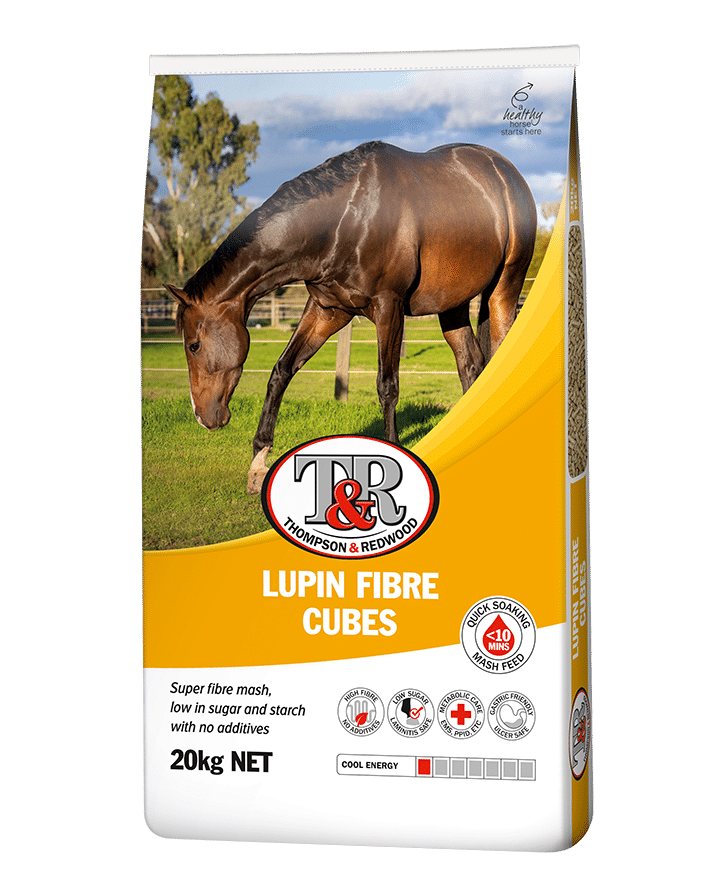

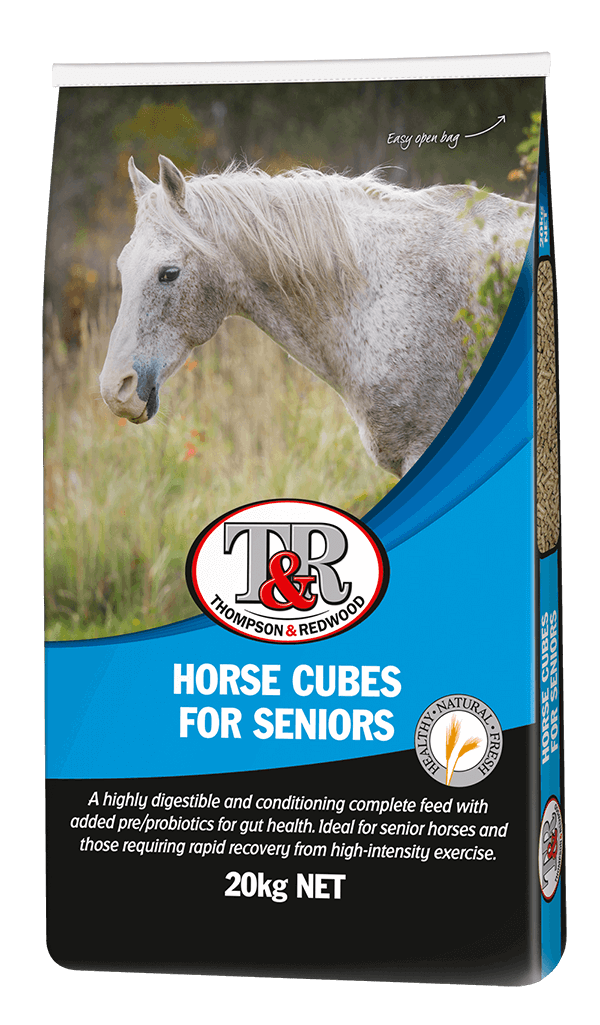
Chaff
Lucerne Chaff is a great option for adding Crude Protein and Lysine to the diet. Lucerne Chaff (and hay) can be great for thoroughbreds as it has been shown to be effective in the prevention or for healing ulcers. But again, watch out for your volume!
TIP: Where feeding chaff, work off 0.5 – 1kg total per day.
Supplementation
Here are a few additional supplements you could add to your hard feeds –
Lysine – an amino acid that horses can only get through what they eat, and enables them to absorb the protein in their feed
Vitamin E – is a biological antioxidant that helps to maintain normal neuromuscular function. If you use a powdered Vitamin E make sure you mix the powder with Linseed Oil or Crushed Linseed to make sure the Vitamin E gets into the blood stream. This is because Vitamin E is a fat-soluble vitamin.
TIP: For horses feed Vitamin E at a rate of 1500IU per day for a horse at rest.
Oil – Oil is a great fat/calorie additive, it is important to feed oil if you feed Vitamin E.
TIP: Add Linseed oil to your feed (80-140ml), or even whole, unground linseeds (125-250g).
Pre and Probiotics – these can help restore the good bacteria in your horse’s gut. A hindgut buffer is another good option, to help balance acidity in the hind gut.
Herbal Blends – Dodson & Horrell offer a great range of herbal supplements. ‘Placid’ and ‘Firm-Foot’ could be two great options for an OTT horse:
o Placid is a natural way to help calm horses who are susceptible to stress, with herbs that help relax and relieve nervous horses. Placid is a horse calmer that works holistically, not by suppressing. The herbs used may not only help to reduce stress for the horse, they may also have a positive effect on the horse’s digestion, muscle tension and inflammation. Buy online now…
o Firm-Foot is designed for shod, barefoot and transitioning horses. It provides a natural way to take care of your horse’s hooves from the inside out. Firm-Foot uses seaweed as a core ingredient, which contains many minerals, amino acids and vitamins, which combined with rosehip, is doing amazing things for horses with hoof issues. Buy online now…
In summary...
Over the coming months with your OTT horse, monitor their
progression with their Body Condition Score and weight. You can use a tape
measure to help estimate weight if you don’t have access to scales.
Read our post on measuring to find out how!
If it looks like your horse is going backwards in condition,
check again for ulcers, or any pain and hoof issues. If you need to add
anything to their feeds, go for fats or oils, lupins and super fibres first.
Remember LONG AND SLOW is the best way to put weight on, and
hopefully creates a calm horse with a trainable temperament!
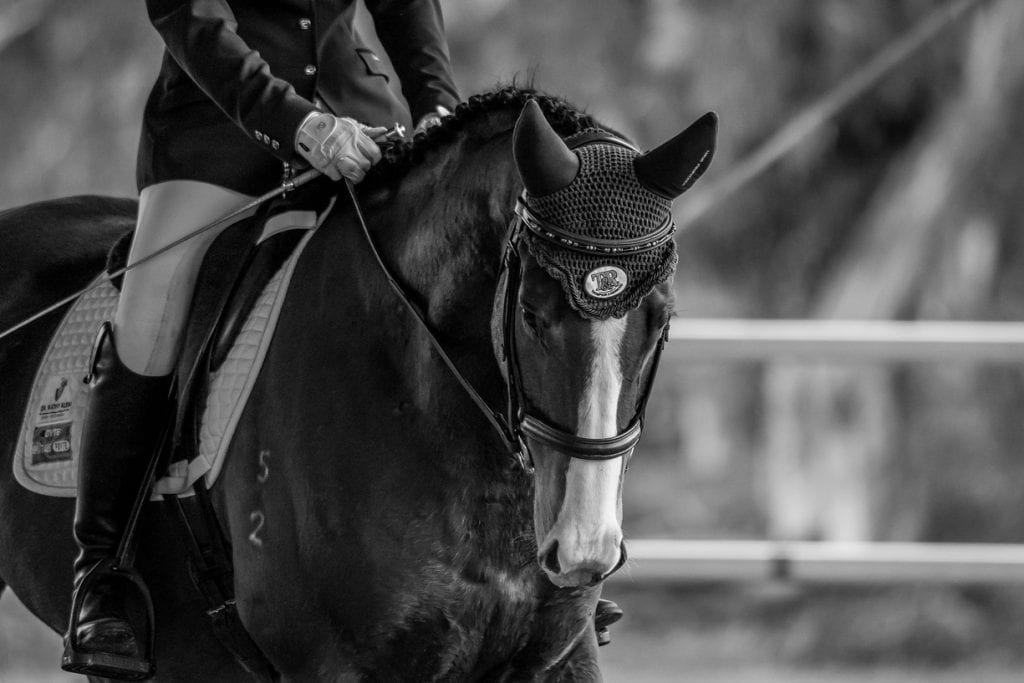
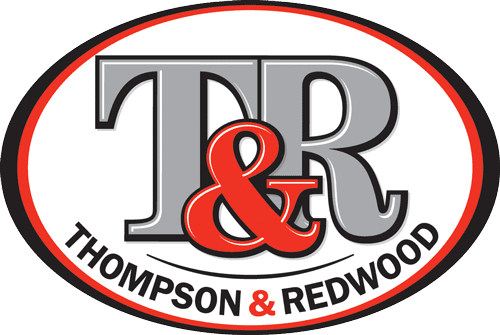


Josephine Clements
Posted at 04:09h, 13 AprilThankyou for putting out this important information on social media, so much to gain and learn. I am about to, fingers crossed to become the Primary Carer of an OTT Racehorse, he was on a High Grain diet, I have been advised he currently is now, in a big paddock with other horses eating grass.
Therefore I want to do everything by the book and carefully, and monitor his progress.
I was pleasantly surprised by your recommendation also of a Herbal formula to calm and relax horse’s and suggested feeds.
Thankyou once again.
Ms. Josephine Clements
PO Box 96 Lalbert VICTORIA 3542